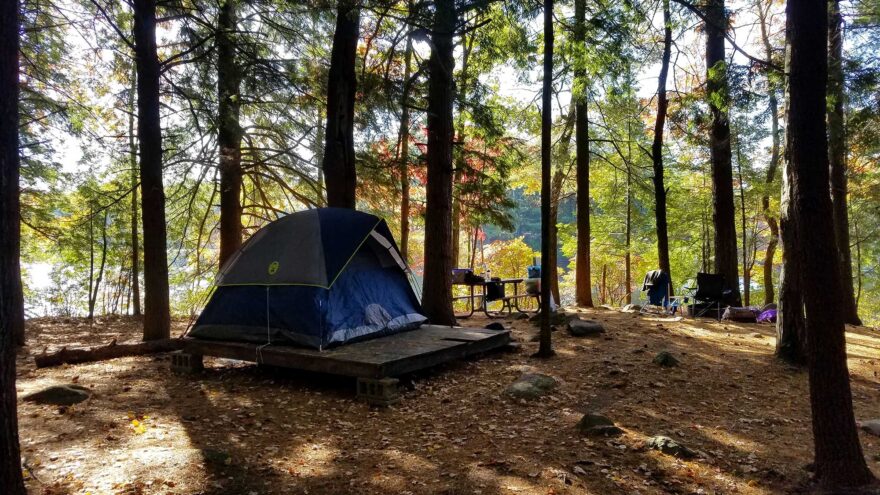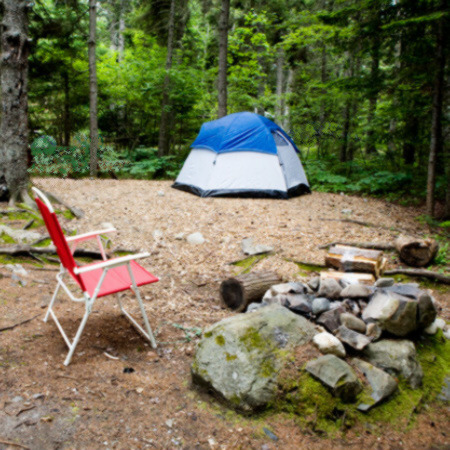
A campsite in New Hampshire. (Image by ajj_photos, Shutterstock)
ActionHub and its parent company were paid a fee to publish this article unedited. The views or opinions expressed here are those of the author and may not reflect those of ActionHub or any of its affiliates.
Setting up the perfect campsite transforms your outdoor experience, creating a comfortable, organized space where you can truly unwind. From choosing the right location to setting up cooking and sleeping areas, this guide will walk you through each step to help you build a campsite that’s safe, cozy, and memorable.
Choosing the Right Location
Building the perfect campsite starts with selecting the right location. A good site can make the difference between a restful, enjoyable stay and a stressful experience. Here are some key factors to consider when choosing your spot:
Scout for Safety
Safety should always be the first priority. Look for an area clear of potential hazards like dead or overhanging branches, which could fall unexpectedly. Avoid spots prone to flooding, especially in valleys or near riverbanks, where water levels could rise overnight. For further guidance, the National Park Service’s camping safety tips provide valuable information to help ensure a safe camping experience.
Accessibility and Comfort
Aim for flat, even ground for sleeping and setting up a cooking area. Areas with natural windbreaks, such as trees or rock formations, offer shelter from strong winds. While proximity to water sources is convenient for cooking and cleaning, it’s wise to keep a safe distance (about 200 feet) to minimize encounters with animals and avoid water contamination.
Respecting Nature
Following Leave No Trace principles is essential to preserving the environment and ensuring that others can enjoy the space after you. Choose durable surfaces to set up your tent and camp, like gravel or sand, to reduce your environmental footprint. Avoid areas with fragile vegetation or habitats that could be disturbed by heavy use.
By carefully selecting a safe, comfortable, and environmentally responsible location, you’ll lay the foundation for a campsite that allows you to enjoy the outdoors while respecting the natural surroundings.
Setting Up the Sleeping Area
Creating a comfortable and secure sleeping area is essential for a restful night’s sleep in the outdoors. Here’s how to set up your sleeping space effectively:
Selecting Your Shelter
Choose a shelter that suits the environment and your comfort needs. Tents are versatile and provide protection from the elements. Ensure your tent is appropriate for the season and weather conditions you’ll encounter.
Sleeping Gear Essentials
Invest in a quality sleeping bag rated for the expected temperatures. A sleeping pad or air mattress adds insulation and comfort, preventing heat loss to the ground. Don’t forget a pillow or improvised headrest for added comfort.
Preparing the Ground
Clear the area of debris like rocks and sticks to create a smooth surface for your tent. If the ground is hard or compacted, using a cordless drill to secure tent stakes can be helpful. Contractor Cave offers a variety of power tools for sale that can assist in this task.
Organizing Your Space
Keep your sleeping area tidy by storing gear in designated spots. Utilize gear lofts or pockets inside your tent to keep essentials like a flashlight or water bottle within reach.
By thoughtfully setting up your sleeping area, you’ll enhance your camping experience with comfort and safety, ensuring you’re well-rested for the adventures ahead.

Creating a Cooking Station
A well-organized cooking station is crucial for safe and efficient meal prep at the campsite. Here’s how to set up a functional, comfortable area for outdoor cooking:
Safety First
Position your cooking area a safe distance from your sleeping area to prevent fire hazards. Follow any local fire regulations, especially in areas prone to wildfires. If open flames are restricted, consider using a portable camp stove as a safe alternative for meal preparation.
Campfire Setup and Alternatives
If fires are allowed, choose a clear, open area for your fire ring, away from overhanging branches or dry brush. Arrange rocks around the firepit to contain the flames, and keep a bucket of water or sand nearby. For campsites that restrict open fires, a portable grill or propane stove can be an excellent alternative, providing safe cooking options without the need for wood.
Organizing Food and Utensils
Keep your cooking space tidy by designating areas for utensils, food, and cleanup supplies. Use a folding table or camp kitchen setup to keep everything accessible and off the ground. Make sure to store food securely, especially in bear country, to prevent wildlife from wandering into your campsite. This guide on essential camping gear provides additional advice on selecting cooking gear that enhances campsite safety and convenience.
By setting up a cooking station with safety and functionality in mind, you’ll enjoy easier meal preparation and a more organized campsite, making your outdoor adventure both delicious and hassle-free.
Establishing a Comfortable Living Space
Creating a cozy, functional living area at your campsite adds a sense of relaxation and enjoyment to your outdoor experience. Here’s how to set up a welcoming space for lounging, socializing, and unwinding:
Seating Arrangements
Choose comfortable seating options that are easy to transport and set up. Folding camping chairs are a classic choice, but for a more rustic feel, consider creating makeshift stools or benches from logs or rocks around your campsite. If you’re staying at the site for multiple days, investing in a portable camping couch or hammock can elevate your comfort level.
Light Sources
Adequate lighting transforms your living area for after-dark relaxation. Battery-powered lanterns, string lights, and solar-powered options are all excellent choices that provide ambient lighting without the need for fire or bulky power sources. Place lights strategically around the seating area and near essential spots like the cooking and sleeping areas to ensure easy navigation after sunset.
Personalizing Your Space
A few simple touches can make your campsite feel more like home. Lay down a small, lightweight tarp or mat in the seating area to create a designated space, protect from dirt, and give the area a cozier feel. Bring along a small folding table for games, snacks, or drinks, and add a couple of blankets for chilly evenings. If you have a hammock, setting it up nearby offers a peaceful spot to relax during the day or under the stars.
By thoughtfully arranging a living space that’s both functional and comfortable, you create a welcoming spot to unwind after a day of exploring, making your camping experience even more enjoyable and memorable.
For additional tips on creating a comfortable campsite, check out this article on camping hacks for a warm night’s sleep.
Conclusion
Building the perfect campsite is all about thoughtful preparation and a few well-planned setups. From choosing a safe, comfortable location and setting up a cozy sleeping area to creating a safe cooking space and a welcoming living area, each element plays a role in making your outdoor experience enjoyable and memorable. Whether you’re a seasoned camper or heading out for the first time, personalizing your site with comfort and convenience in mind allows you to fully relax and appreciate the natural beauty around you.
Remember, the best campsites are not only comfortable but also respectful of nature. By following Leave No Trace principles, you help preserve the environment for future campers to enjoy. So get ready to pitch that tent, light up the campfire, and settle in — your perfect campsite awaits!
 Your Privacy Choices
Your Privacy Choices
 The
The